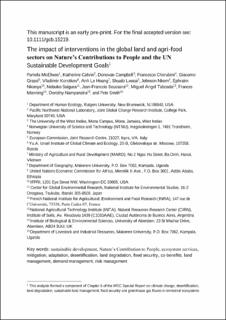The impact of interventions in the global land and agri-food sectors on Nature’s Contributions to People and the UN Sustainable Development Goals
| dc.contributor.author | McElwee, Pamela | |
| dc.contributor.author | Calvin, Katherine | |
| dc.contributor.author | Campbell, Donovan | |
| dc.contributor.author | Cherubini, Francesco | |
| dc.contributor.author | Grassi, Giacomo | |
| dc.contributor.author | Korotkov, Vladimir | |
| dc.contributor.author | Le Hoang, Anh | |
| dc.contributor.author | Lwasa, Shuaib | |
| dc.contributor.author | Nkem, Johnson | |
| dc.contributor.author | Nkonya, Ephraim | |
| dc.contributor.author | Saigusa, Nobuko | |
| dc.contributor.author | Soussana, Jean‐Francois | |
| dc.contributor.author | Taboada, Miguel Angel | |
| dc.contributor.author | Manning, Frances C. | |
| dc.contributor.author | Nampanzira, Dorothy | |
| dc.contributor.author | Smith, Pete | |
| dc.date.accessioned | 2021-09-23T06:43:25Z | |
| dc.date.available | 2021-09-23T06:43:25Z | |
| dc.date.created | 2020-09-02T16:08:47Z | |
| dc.date.issued | 2020 | |
| dc.identifier.citation | Global Change Biology. 2020, 26 (9), 4691-4721. | en_US |
| dc.identifier.issn | 1354-1013 | |
| dc.identifier.uri | https://hdl.handle.net/11250/2780615 | |
| dc.description.abstract | Interlocked challenges of climate change, biodiversity loss, and land degradation require transformative interventions in the land management and food production sectors to reduce carbon emissions, strengthen adaptive capacity, and increase food security. However, deciding which interventions to pursue and understanding their relative co-benefits with and trade-offs against different social and environmental goals have been difficult without comparisons across a range of possible actions. This study examined 40 different options, implemented through land management, value chains, or risk management, for their relative impacts across 18 Nature's Contributions to People (NCPs) and the 17 Sustainable Development Goals (SDGs). We find that a relatively small number of interventions show positive synergies with both SDGs and NCPs with no significant adverse trade-offs; these include improved cropland management, improved grazing land management, improved livestock management, agroforestry, integrated water management, increased soil organic carbon content, reduced soil erosion, salinization, and compaction, fire management, reduced landslides and hazards, reduced pollution, reduced post-harvest losses, improved energy use in food systems, and disaster risk management. Several interventions show potentially significant negative impacts on both SDGs and NCPs; these include bioenergy and bioenergy with carbon capture and storage, afforestation, and some risk sharing measures, like commercial crop insurance. Our results demonstrate that a better understanding of co-benefits and trade-offs of different policy approaches can help decision-makers choose the more effective, or at the very minimum, more benign interventions for implementation. | en_US |
| dc.language.iso | eng | en_US |
| dc.publisher | Wiley | en_US |
| dc.title | The impact of interventions in the global land and agri-food sectors on Nature’s Contributions to People and the UN Sustainable Development Goals | en_US |
| dc.type | Journal article | en_US |
| dc.description.version | submittedVersion | en_US |
| dc.rights.holder | This is the authors' manuscript to an article published by Wiley | en_US |
| dc.source.pagenumber | 4691-4721 | en_US |
| dc.source.volume | 26 | en_US |
| dc.source.journal | Global Change Biology | en_US |
| dc.source.issue | 9 | en_US |
| dc.identifier.doi | 10.1111/gcb.15219 | |
| dc.identifier.cristin | 1826865 | |
| dc.relation.project | Norges forskningsråd: 286773 | en_US |
| dc.relation.project | Norges forskningsråd: 294534 | en_US |
| cristin.ispublished | true | |
| cristin.fulltext | preprint | |
| cristin.qualitycode | 2 |
